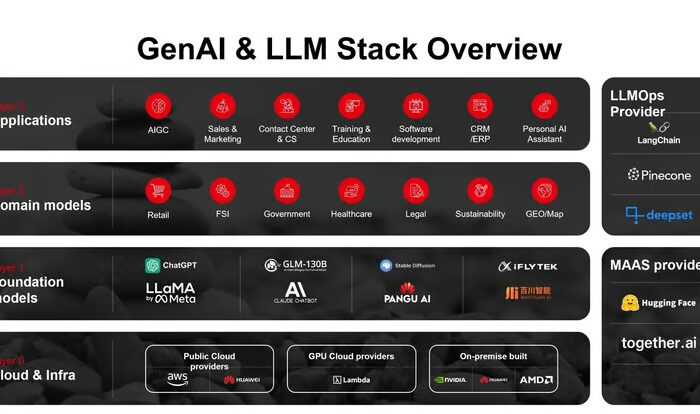
China’s AI industry is rapidly evolving amidst growing tensions with the United States, as exemplified by OpenAI’s recent move to block API access in China. This development has accelerated the race among Chinese tech giants, established AI specialists, and emerging startups to develop homegrown AI technologies while navigating the challenges posed by the ongoing “AI Cold War” between the two global superpowers.
This is the first of a two-part piece that aims to give readers a deeper understanding of the Chinese AI space, its players, and the ramifications of the China-US AI ecosystem split.
The Current Status Quo of China AI Companies
Introducing the different groups of players in the Chinese AI space:
1. The Giants: Baidu, Alibaba, Tencent, Bytedance and Huawei

The Chinese Tech Goliaths by stability.ai
China’s tech giants have emerged as significant players in the AI landscape, leveraging their vast resources and user bases to develop cutting-edge AI technologies.
- Baidu has positioned itself as a leader with its Ernie Bot, which is comparable to GPT -4 in capabilities.
- Alibaba Cloud released its Qwen 2 large language model series, topping rankings for open-sourced LLMs.
- Tencent unveiled Hunyuan, a proprietary foundation model for generating images and text.
- ByteDance, TikTok’s parent company, is collaborating with Broadcom to develop advanced AI chips and has released its own LLM, Doubao.
- Huawei announced Pangu model 5.0, focusing on the industrialisation of AI models across multiple verticals.
The competitive edge of each player varies; e.g. Baidu plays the strength of its algorithm and data behind its search engine and its rising capabilities of autonomous driving. Alibaba and Tencent draw upon their datasets across their e-commerce, social, gaming ecosystems, etc. Bytedance has the richest video and audio datasets, making it China’s most formidable multimodal provider. Last but not least, HUAWEI, the only commercially viable Chinese AI hardware provider, Ascend Computing, can offer alternative GPUs to all players in the Chinese market. That said, this capability is only limited to the Chinese market, with limited access to overseas companies given the US sanction.
Compared to other AI players, a critical competitive edge of the giants’ AI offerings is often additions to their existing product offerings and capabilities. These giants can leverage their existing product offerings as channels to upsell these AI offerings, either as an improvement to their client’s existing product shelf or as an addition, a bundle, if you will. For example, both ByteDance and Alibaba have enterprise workplace product offerings, e.g. Feishu and DingDing, which will become channels to sell their respective AI product offerings.
2. The Specialists: The Four Dragons vs the Four Tigers

by stability.ai
China’s “Four AI Dragons” represent the vanguard of China’s artificial intelligence industry, particularly in computer vision and facial recognition technologies. These companies were established in the earlier part of the 2000s and 2010s. Each company has carved out a unique niche while contributing to China’s ambitions of becoming a global AI leader.
- SenseTime specialises in facial recognition, image recognition, and deep learning algorithms.
- Megvii is best known for its Face++ platform, which offers computer vision technologies for applications ranging from smartphone security to city-wide surveillance systems.
- CloudWalk has leveraged its research background to develop advanced facial recognition systems widely used in banking and public security.
- Yitu Technology focuses on developing AI solutions for the healthcare, public safety, and finance sectors.
China’s “Four New AI Tigers” refer to a group of emerging artificial intelligence startups that have gained significant attention and investment in recent years. They are considered China’s best hopes for reaching frontier ChatGPT-like technology, focusing on generative AI technologies, including large language models (LLMs) and chatbots.
- Baichuan has made significant strides in developing a large language model (LLM), releasing three versions of its namesake AI models.
- Zhipu AI‘s GLM-4 model represents a significant advancement in Chinese language processing capabilities and is also venturing into multimodal AI, with plans to launch a text-to-video competitor to OpenAI’s Sora.
- Moonshot AI has gained prominence with its Kimi chatbot, which boasts an impressive capacity to handle vast amounts of data in a single prompt, able to process up to 2 million Chinese characters in one interaction.
- MiniMax is making strides in generative AI development, focusing on building advanced language models. It offers two AI character role-playing apps to the US (Talkie) and China (Xinye) markets.
These companies mark a shift from the previous generation of AI companies that concentrated on computer vision and facial recognition. This pivot towards foundational models, e.g. large language model (LLM), aligns with global trends following the success of OpenAI and others. However, each is hindered by the same problem – wooing GenAI app makers to use their model when the underlying model capabilities are becoming too similar and competitive in price. Lastly, they all live under the shadow of the giants, lacking the rich datasets that Baidu and Bytedance possess and Huawei’s access to end-to-end AI hardware stack.
3. The New Kids on the Block – Emerging AI Apps
More than hundreds of models and LLM are now being created in China, often referred to as the model war of hundreds, as I mentioned in my last blog.

20 models of hundreds in China
You can download the complete list here
At the World Artificial Intelligence Conference (WAIC) 2024, Baidu CEO Robin Li warned of too many models—“in 2023, intense competition amongst over 100 LLMs has emerged in China” and too few applications. “I’ve noticed that many people still primarily focus on foundational models… how about real-world applications?”

WAIC 2024 – James Ong, Artificial Intelligence International Institute
This model war will conclude in the next 12 months. Only one or two of the four tigers will prevail, and most of the hundreds will disappear. The giants will acquire some. The ones lagging behind in app maker popularity will fall first, indicating that the AI app makers are at the centre stage of China’s AI scene.
Here are some of the more popular AI apps in China:
| Product | Product Type | Company Background | Monthly monthly Traffic | Comparison |
|---|---|---|---|---|
| ai.360.com | Ai chatbot | Zhou Hongyi | 136K | ChatGPT |
| ELSA | AI edtech | Vu Van | 2.2M | Liulishuo |
| Liulishuo | AI edtech | Yi Wang | 20.5K | VIPKid |
| Miaobi | AI writing platform | Xinhua | 65.7K | Grammarly |
| Tiangong | AI chatbot | Kunlun Wanwei | 3.3M | ChatGPT |
| Wanzhi | AI assistant | 01.AI | 320K | ChatGPT |
| X Eva | AI companion | Xiaoice | TBC | Character.ai |
| Xingye | AI avatar maker | MiniMax | 73.6K | Character.ai |
Rather than be sucked into the expensive task of building LLMs, these companies are focused on leveraging existing models to create applications, predominantly servicing the B2C market with AI chatbots, companions, image and video generation tools. The most popular apps are ChatGPT alternatives,
The split of the AI ecosystem has not impacted the AI App makers. It is quite the opposite, as these app makers benefit from the price war between all the LLM providers in China. The better prepared ones are on their way to expand overseas , e.g. moving to Singapore to stay away from the impact. Also, this creates an emerging sector of independent developers who will challenge the global SaaS and B2C app market and profoundly impact the rest of the world.
What’s next?
- What are China’s AI companies’ countermeasures in the midst of the global AI ecosystem split?
- How will it impact the rest of the world?
- What are the risks and opportunities for startups and enterprises in Asia?
I will cover this in the 2nd part of this article, which is scheduled for next week – Part 2: Is winter here or not? These are things you should know and take action on as an Asian enterprise and startup.
Stay tuned!
If you enjoyed the content, we would greatly appreciate it if you subscribed to our newsletters.
Subscribe To Get Update Latest Blog Post


Leave Your Comment: